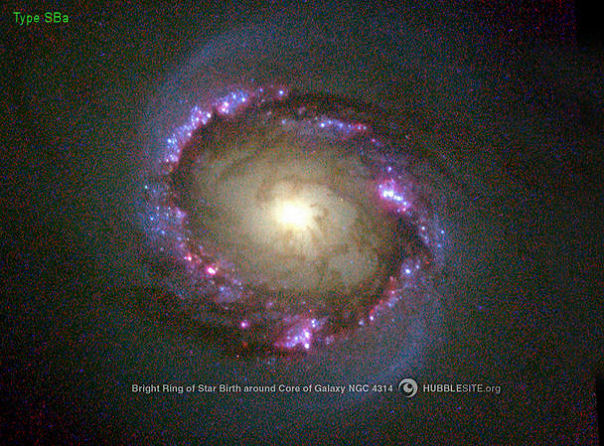§ Spiral Galaxies
Spiral
A curve on a plane that winds around a fixed center point at a continuously increasing or decreasing distance from the point. — The American Heritage® Dictionary of the English Language, Fourth Edition
Spiral Galxy
A flat, rotating disk containing stars, gas and dust, and a central concentration of stars known as the bulge. These are surrounded by a much fainter halo of stars, many of which reside in globular clusters...named for the (usually two-armed) spiral structures that extend from the center into the disk. The spiral arms are sites of ongoing star formation and are brighter than the surrounding disk because of the young, hot OB stars that inhabit them. — Wikipedia
§ Contents of Chapter Two
- The Spiral Galaxy
Types of Spirals Intro — Expanding the Classification System - The Armless Galaxies of S Zero
The First Spiral Type — The Cat and the Giraffe — The Perfect S0 & SB0 Galaxy - Galaxies of the Sa & SBa Class
Tightly Wound Spiral Arms, Large Central Nuclei — or Say Ess-Be-a — The Perfect Sa & SBa Galaxy - Subsequent chapters under construction
Spiral Galaxies — Types Sb, SBb, Sc & SBc
1. The Spiral Galaxy
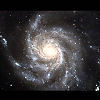 Scientific thought at the turn of the 20th century was premised on the theory that our galaxy remained static, comprising the entire known universe; within it were to be found other stellar agglomerations then called "spiral nebulae". Astronomers Harlow Shapley and Heber D. Curtis were decidedly in disagreement with one another over this and other points, leading to the "great debate" of the 1920s. The two astronomers argued whether our galaxy comprised the entire universe (Shapley) and whether the "spiral nebulae" seen in telescopes were other galaxies like our own (Curtis) or just nebulous clouds of gas. In a contrast of arguments, Curtis placed the Sun near the center of our Galaxy while Shapley placed it far from the galatic center. Through the work of Edwin Hubble and others, by the 1930s the debate was settled: our Galaxy was much larger than first determined, the sun was not at the center of the galaxy and the "spiral nebulae" were indeed other spiral galaxies beyond the borders of our own, existing within the vastness of an expanding universe. — Shown left is The Pinwheel Galaxy, NASA [1]
Types of Spirals Intro
Scientific thought at the turn of the 20th century was premised on the theory that our galaxy remained static, comprising the entire known universe; within it were to be found other stellar agglomerations then called "spiral nebulae". Astronomers Harlow Shapley and Heber D. Curtis were decidedly in disagreement with one another over this and other points, leading to the "great debate" of the 1920s. The two astronomers argued whether our galaxy comprised the entire universe (Shapley) and whether the "spiral nebulae" seen in telescopes were other galaxies like our own (Curtis) or just nebulous clouds of gas. In a contrast of arguments, Curtis placed the Sun near the center of our Galaxy while Shapley placed it far from the galatic center. Through the work of Edwin Hubble and others, by the 1930s the debate was settled: our Galaxy was much larger than first determined, the sun was not at the center of the galaxy and the "spiral nebulae" were indeed other spiral galaxies beyond the borders of our own, existing within the vastness of an expanding universe. — Shown left is The Pinwheel Galaxy, NASA [1]
Types of Spirals Intro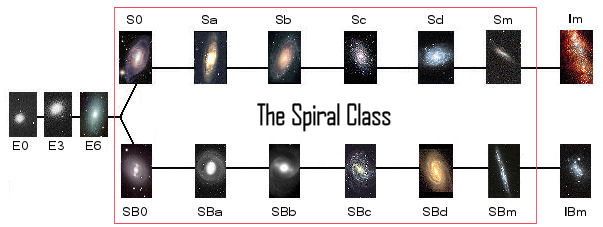 Looking at our modern Tuning Fork diagram from chapter one, we see that the spiral class comprises the largest group of galalxy types within our universe (red box), approximately 60% of all galaxies currently known. The spiral group then forms two distinct branches, each cotaining a sub—type that give the diagram its tuning fork appearance; we'll discuss the sub-types and their composition further below.
Looking at our modern Tuning Fork diagram from chapter one, we see that the spiral class comprises the largest group of galalxy types within our universe (red box), approximately 60% of all galaxies currently known. The spiral group then forms two distinct branches, each cotaining a sub—type that give the diagram its tuning fork appearance; we'll discuss the sub-types and their composition further below.For the moment, the spiral galaxies fall into three distinct morphological types: Lenticular (S0), Unbarred Spiral (S) and Barred Spiral (SB). These in turn have a further classification according to the structural appearance of the galaxy's arms (Sa, Sb, SBa, SBb). This system is one based on empirical or subjective grounds and as such, has received its fair share of criticism, it being pointed out that the guidelines can lead to erroneous classification assignments amongst galaxies. While they have occured, these have been few and it remains the most popular and used system amongst scientists and amateur astronomers alike. [2]
Expanding the Classification System
Another classification system in use today is the one developed by the French astronomer Gérard de Vaucouleurs who expanded upon the standard Hubble scheme ( as did others like Morgan in 1958, van den Bergh in 1960 and Sandage in 1975 ) by including other compositional components in his classification of galaxies. These were namely the inclusion of "rings", "lenses" and a numerical or "T" value in the range of -6 to 10, that tracks the stage of a galaxy from early to late-types and is the classification system used in the 1991 Reference Catalogue of Bright Galaxies. Shown below is an image displaying a part of de Vaucouleurs' morphological table of classification as well as several labeled examples of the various types within this system. [3]
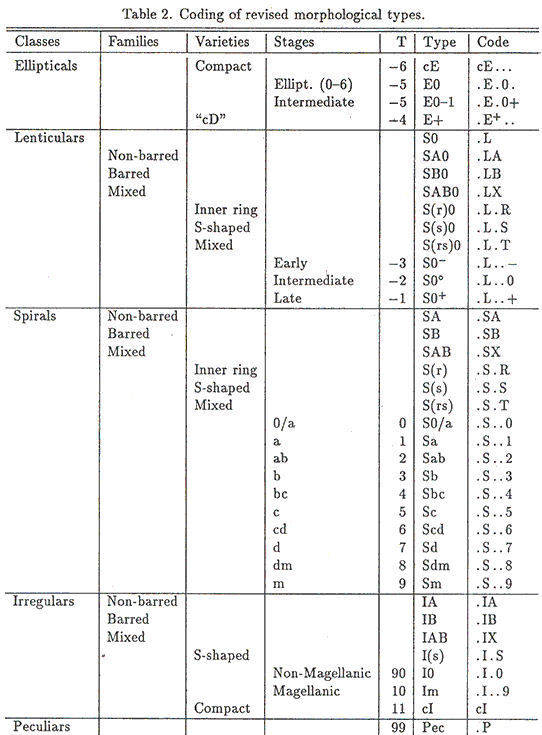
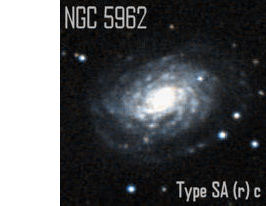

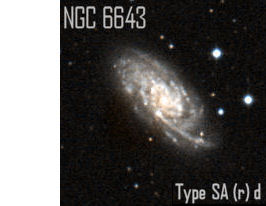
Gérard de Vaucouleurs' system developed out of his belief that the morphological classification of Hubble's scheme was not broad enough as it did not allow for other observable characteristics within galaxy types. Building upon Hubble's original classification of primary types, ellipticals, lenticulars, spirals and irregulars, his system offered several advantages when intergrated with Hubble's: omission of types that are indiscernible and a stage format comprised of bulge/disk, pitch angle and resolution of arms into HII regions. Professor Ronald Buta, in a paper reviewing the historical and present day issues of morphological classification, notes:
De Vaucouleurs presented a personal revision of Hubble's system that provides a better description of what a galaxy looks like without being too complicated. The system uses the concept of a classification volume, rather than a simple multi-pronged "tuning fork", and is recognized mainly for its addition of stages later than Sc, called Sd and Sm, and for the notation (SA, SAB, and SB) used to denote continuity of the bar characteristic. These revisions to Hubble's system have been largely accepted by most astronomers. The Sm class is particularly important because it recognized the Magellanic Clouds not simply as "irregulars" but as very late spirals with no spheroidal component. [4]
Other systems or revisions in use today include the Yerkes, also referred to as the Morgan classification scheme developed by American astronomer William Wilson Morgan who developed the MKK system, a classification of stars through their spectra, with Philip Keenan and American astronomer Allan Sandage's extentsion to the system, which includes features introduced by astronomers Gérard deVaucouleurs and Sidney van den Bergh. For more information on these classification systems see the Selected Sources of Secondary Works below.
2. The Armless Galaxies of S Zero
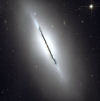 The image highlights the galaxy's structure: a subtle, reddish bulge surrounding a bright nucleus, a blue disk of stars running parallel to the dust lane, and a transparent outer halo. NGC 5866 is a disk galaxy of type "S0" (pronounced s-zero). Viewed face on, it would look like a smooth, flat disk with little spiral structure. It remains in the spiral category because of the flatness of the main disk of stars as opposed to the more spherically rotund (or ellipsoidal) class of galaxies called "ellipticals." Such S0 galaxies, with disks like spirals and large bulges like ellipticals, are called 'lenticular' galaxies. — HubbleSite News article describing the lenticular galaxy NGC 5866 shown left, The Hubble Heritage Team [5]
The First Sprial Type
The image highlights the galaxy's structure: a subtle, reddish bulge surrounding a bright nucleus, a blue disk of stars running parallel to the dust lane, and a transparent outer halo. NGC 5866 is a disk galaxy of type "S0" (pronounced s-zero). Viewed face on, it would look like a smooth, flat disk with little spiral structure. It remains in the spiral category because of the flatness of the main disk of stars as opposed to the more spherically rotund (or ellipsoidal) class of galaxies called "ellipticals." Such S0 galaxies, with disks like spirals and large bulges like ellipticals, are called 'lenticular' galaxies. — HubbleSite News article describing the lenticular galaxy NGC 5866 shown left, The Hubble Heritage Team [5]
The First Sprial Type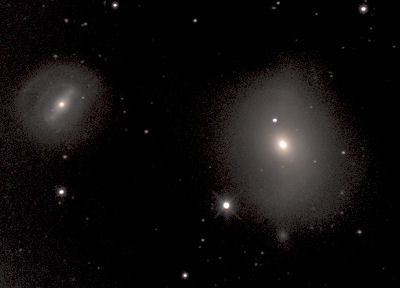 In a journal report on lenticular galaxy formation, Sudhanshu Barway et. al. noted, "When comparing properties, it is found that the bulges of lenticulars are very similar to elliptical galaxies, while their disks have similarities to the disks of early-type spiral galaxies, except that they lack conspicuous spiral arms." It is for this reason that lenticular galaxies occupy the central point before the branch in Hubble's tuning fork classification of galaxies, a hierarchy that applies equally well to the other systems in use. It has also been suggested that a portion of these types of galaxies are simply "faded spirals", a hypothesis that was tested with favorable results in 2006. [6]
In a journal report on lenticular galaxy formation, Sudhanshu Barway et. al. noted, "When comparing properties, it is found that the bulges of lenticulars are very similar to elliptical galaxies, while their disks have similarities to the disks of early-type spiral galaxies, except that they lack conspicuous spiral arms." It is for this reason that lenticular galaxies occupy the central point before the branch in Hubble's tuning fork classification of galaxies, a hierarchy that applies equally well to the other systems in use. It has also been suggested that a portion of these types of galaxies are simply "faded spirals", a hypothesis that was tested with favorable results in 2006. [6]As the classification scheme of galaxies might suggest, their placement within the systems currently in use seem to have the inherent characteristic of a class based upon evolutionary developement; to a certain extent, perhaps. This is of course, at the crux of changes to the system and why it still remains a subjective classification scheme as opposed to the criteria used for classifying stars within the H-R Diagram that clearly define their stellar evolution. Put another way, [t]he purpose of any classification is not only to separate objects into distinct classes but also to seek an understanding of the relationships between the classes. Two aspects of the Hubble galaxy types are suggestive of a progressive relationship between the several types. The first is the distinction between pure stellar systems versus those with some content of interstellar material. Second, but related to the first, is a recognizable trend from "round" to "flat" galaxies. Seen above is an image of Lenticular Galaxy M85 (S0) and NGC 4394 (left in image), a sprial galaxy of SBb type. This wonderful stellar vista is courtesy Kristin Datema and the Calvin College Observatory. [7]
While much is known about the evolution of stars the opposite is true for galaxies. Originally thought to form from the collaspe of large gas clouds in what is known as a "top—Down" process, it is now thought that galaxy formation is a "bottom-up" process involving coalescence of smaller progenitors and accretion. As the gas within a small area of mass quickly contracts, it builds rotational momentum until the final result is a very thin, very rapidly rotating disk. Another theory posits galaxy formation from the clustering of dark matter halos in another bottom-up process. fn1
While more recent scientific thought and research on the evolution of galaxies is based in the study and understanding of their stars and stellar populations, the visual classification scheme remains the best indicator of a galaxy's structural evolution and not a definitive diagram or tool for evolutionary developement, a process that remains one of the unresolved challenges of astronomy today (see also Dynamical Evolution of Disk Galaxies, J. A. Sellwood, 2007). As noted by the School of Physics and Astronomy, University of Nottingham, in discussing studies on nearby galaxies using the Tully-Fisher relation: fn2
Lenticular (S0) galaxies live at the crossroads between Elliptical and Spiral galaxies in Hubble's tuning-fork diagram. Understanding how they form and evolve is essential if we wish to have a complete picture of how galaxy morphology is related to galaxy formation and the environment. HST observations indicate that the proportion of S0 galaxies is substantially smaller in distant (z~0.5) clusters than in nearby ones, while spirals show the opposite trend. It therefore seems plausible that spiral galaxies falling into clusters have their star formation extinguished by the cluster environment and evolve into S0s. Hydrodynamical simulations of the interaction of the gaseous components of disk galaxies with the intra-cluster medium seem to support these ideas but the evidence is all highly circumstantial. [8]
The Cat and the Giraffe
Just north of Leo and Cancer lies a mostly blank sky wherein resides the Lynx, a constellation introduced in the 17th century by Johannes Hevelius, and the constellation Camelopardalis, also known as "the Giraffe", a constellation which may have first appeared in a book by German astronomer Jakob Bartsch in 1624. Located in the Lynx, at right ascension 08 18 58.4 and declination +57 48 09, is NGC 2549, another S0 type galaxy seen in the center of the image below left. With stars around magnitude 4.0 for the Giraffe and 3.3 magnitude visual brightness within the Lynx, these constellations can be a difficult find for amateur astronomers and many wide field images of this area seem almost uninteresting, devoid of any deep sky objects. The second image, below right, gives a good idea as to the comparable naked eye view of stars within the Lynx, lined-in to show the constellation. Image of NGC 2549 courtesy the Astronomerica - SDSS Images website. The Lynx constellation courtesy Till Credner and Sven Kohle © AlltheSky.com website.
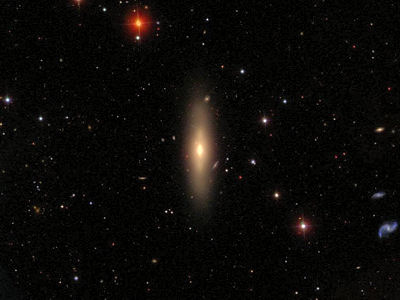
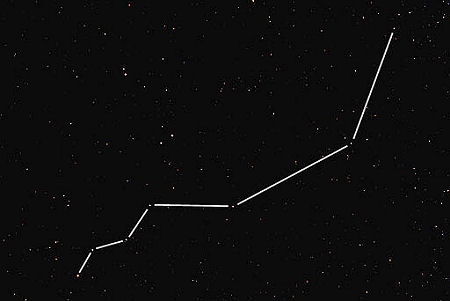
In discussing the morphology of S0-type galaxies like NGC 2549 above, the Sloan Digital Sky Survey site notes:
NGC 2549 is an example of a lenticular galaxy, seen nearly edge-on. Lenticular galaxies are disk galaxies without visible spiral structure, and get their name because they often resemble a lens seen edge-on. In the Hubble classification, they are regarded as an intermediate between spiral and elliptical galaxies. Three structural components frequently seen in galaxies are pronounced in this image: a bright central disk, a bright central envelope, and a faint extended envelope. Several smaller galaxies can be seen in this image; such companion galaxies are common around large galaxies. [9]
Shown below is the galaxy NGC 2646, an example of the SB0 or barred lenticular type, located in the constellation Camelopardalis. In the inset at lower right is a negative image of the galaxy highlighting its two bars. The galaxy was discovered by Ernst Wilhelm Leberecht Tempel on July 27, 1883. Tempel discovered—along with 150 other NGC objects—the galaxy while at Arcetri Observatory near Florence using a 11-inch f/19 refractor that Tempel called the "Amici I". The below image is from photographic plates of the Palomar Observatory Sky Survey (POSSII), Space Telescope Science Institute (STScI), and made available through the Aladin previewer utility.

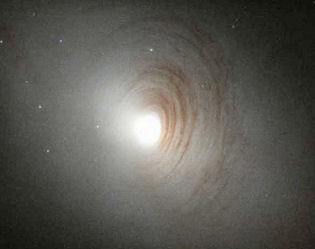 At right is NGC 2787, another SB0 galaxy is which is additionally classed as a LINER-type Active Galaxy Nucleus (See previous chapter). Notes the editors of the Astronomy Picture of the Day website (APOD), where this image was obtained:
At right is NGC 2787, another SB0 galaxy is which is additionally classed as a LINER-type Active Galaxy Nucleus (See previous chapter). Notes the editors of the Astronomy Picture of the Day website (APOD), where this image was obtained:Lenticular galaxies aren't supposed to be photogenic. Like spiral galaxies, they contain a disk, but like elliptical galaxies, they are usually short on dust, gas, and pretty spiral arms. Lenticulars are relatively little studied, possibly because of their seemingly benign nature. Famous galaxies historically classified as lenticular include M84, M85, and M86. Recent pictures and evidence, however, indicate that lenticulars can be both photogenic and scientifically interesting. For example, the above image of NGC 2787 taken with the Hubble Space Telescope shows that the center of this lenticular galaxy has interesting structure. The image was taken to help determine how lenticular galaxies formed, and what happens in their centers. The span of NGC 2787 in the above image is about 4500 light years, while the galaxy lies about 25 million light years away toward the constellation of Ursa Major. Authors & Editors: Robert Nemiroff (MTU) & Jerry Bonnell (UMCP) Credit: Marcella Carollo (ETHZ), Hubble Heritage, NASA.
The Perfect S0 & SB0 Galaxy
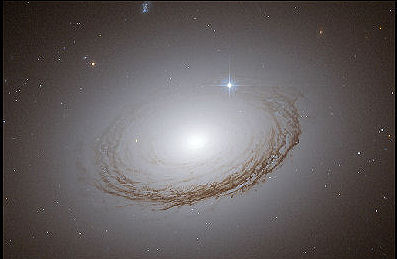

Given that galaxies are organized via a subjective analysis of their form, it seems only fitting to choose two that represent the class in a like manner. At left is seen the S0 Galaxy NGC 7049 and the double entered NGC 1269 at right which is also cataloged as NGC 1291. Originally discovered by James Dunlop in 1826 and entered as NGC 1291 into the NGC catalog by John Louis Emil Dreyer, it was again discovered by John Herschel in 1836 whereupon Dreyer once more entered it into the NGC catalog as NGC 1269, without having taken notice of its twin identity. [10]
Located at right ascension 21 19 00.30 and declination -48 33 42.6, NGC 7049 is a very prominent S0 galaxy in the constellation Indus, a small southern constellation which appeared in the 1603 publication Uranometria, written by German stellar cartographer Johann Bayer. Its position in the sky is commanding and the region wherein it resides is collectively known as the NGC 7049 GROUP. The above image was recently taken by the Hubble Space Telescope and appeared in April 2009 on the APOD website. Notes the editors of APOD, "Since NGC 7049 is the brightest galaxy in its cluster of galaxies, its formation might be fostered by several prominent and recent galaxy collisions. NGC 7049 spans about 150 thousand light years and lies about 100 million light years away toward the constellation of Indus." Credit: NASA, ESA and W. Harris of McMaster University.
Our other aesthetic gem, NGC 1269, is located at right ascension 03 17 18.44 and declination -41 06 56.9, about 33 million light-years away in the constellation Eridanus ("the River"), one of Greek astronomer Ptolemy's original 48 constellations. This is a galaxy that is immediately noticeable by its unusual inner bar and outer ring structure, giving it a morphological classification of SB0-a. Image of NGC 1269 courtesy Josef Pöpsel, taken from the Capella Observatory at Amani Lodge September 14th, 2004, © 2005. fn3 [11]
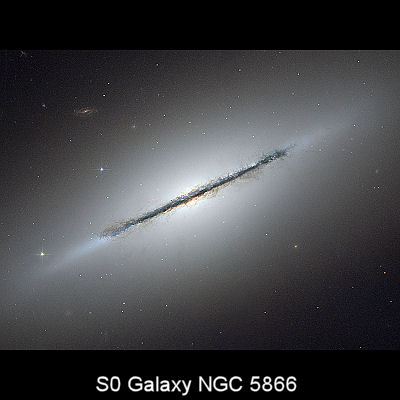

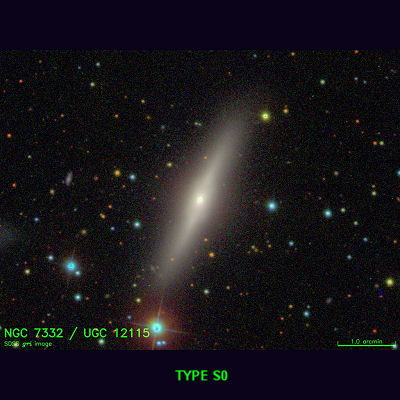
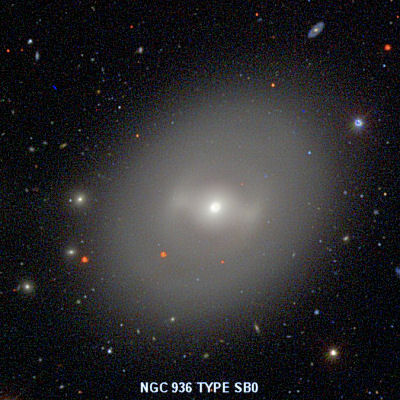
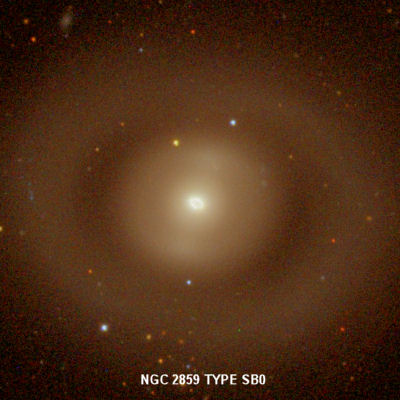
Credit & Copyrights: NGC 5866 courtesy NASA, ESA, and The Hubble Heritage Team (STScI/AURA). All other images courtesy David W. Hogg, Michael R. Blanton, and the Sloan Digital Sky Survey Collaboration. Acknowledgments: W. Keel of the University of Alabama; David W. Hogg of The Center for Cosmology and Particle Physics
Footnotes
1. Dark matter is hypothetical matter that is undetectable by its emitted radiation, but whose presence can be inferred from gravitational effects on visible matter.
2. The Tully-Fisher relation was published by astronomers R. Brent Tully and J. Richard Fisher in 1977. It is the empirical relationship between the intrinsic luminosity of a spiral galaxy and its velocity width or amplitude of its rotation curve. See Tully, R. B. & Fisher, J. R., A new method of determining distances to galaxies, Astronomy and Astrophysics, vol. 54, no. 3, Feb. 1977, p. 661-673., 1977A&A....54..661T
3. Morphological type for NGC 1269 under the de Vaucouleurs classification system is RSBS0. Under the Hubble system the Uppsala General Catalog of Galaxies uses the designation of S3 3 A. Source: MCG Vol.5 (Vorontsov-Velyaminov+, 1974), which is the Morphological Catalog of Galaxies wherein NGC 1269 is listed as MCG MCG-07-07-008.
3. Galaxies of the Sa & SBa Class
Bibliography
- The Shapley - Curtis Debate in 1920 The Scale of the Universe. This web page was organized by the editors of Astronomy Picture of the Day, Robert Nemiroff (MTU) & Jerry Bonnell (USRA)
- Galaxies: Classification, Formation, and Evolution, Lecturer Ana M. Larson, Ph.D., University of Washington Astronomy Department. Page last updated on: Tue, 09 Dec 2008 20:13:37 GMT
- Whittle, Professor Mark EXTRAGALACTIC ASTRONOMY, ASTR 553/4 Graduate Extragalactic Astronomy at the University of Virginia Department of Astronomy Copyright © 2002-2005. Images of NGC 1553, 5962 and 6643 were obtained from the The ALADIN interactive sky atlas.
- Buta, Ronald The Morphological Classification of Galaxies pg.2, University of Alabama Box 870324, Tuscaloosa, AL 35487. In "Physics of Nearby Galaxies: Nature or Nurture?", 1992 T. X. Thuan, C. Balkowski, and J. T. Thanh Van, eds., Editions Frontieres, Gif-Sur-Yvette, p. 3
- HubbleSite News Release Number: STScI-2006-24, Hubble Sees Galaxy on Edge, above quote and image from the June 8, 2006 news release. Image credit: NASA, ESA, and The Hubble Heritage Team (STScI/AURA) Acknowledgment: W. Keel (University of Alabama, Tuscaloosa)
- Sudhanshu Barway et. al. LENTICULAR GALAXY FORMATION: POSSIBLE LUMINOSITY DEPENDENCE pg.1 published by The Astrophysical Journal, 661: L37—L40, 2007 May 20. Received 2007 February 18; accepted 2007 March 26; published 2007 April 19, © 2007 The American Astronomical Society. All rights reserved. Also see ARAGÓN-SALAMANCA A. et. al. Measuring the fading of S0 galaxies using globular clusters Astronomy and Astrophysics, ISSN 0004-6361, CODEN AAEJAF 2006, vol. 458, no1, pp. 101—105
- Galaxy Types and Classifications New York NY Hubble "tuning fork" diagram for classification from Articles.DirectoryM.com. "The galaxy types therefore appear to be fundamentally different for reasons other than dynamical evolution. A deciding factor appears to be the fraction of material in old stars versus old/young stars in disks." Copyright © Interaction Media Group. All rights reserved. 10 September, 2009
- Formation and Evolution of Galaxies The formation and evolution of Lenticular (S0) galaxies, page maintained by Alfonso Aragón-Salamanca, School of Physics and Astronomy, University of Nottingham. Last Revision: November 2nd 2006. Used with the kind permission of Prof. Alfonso Aragón-Salamanca
- Sloan Digital Sky Survey Image of the Week Archive The Sloan Digital Sky Survey (SDSS) is one of the most ambitious and influential surveys in the history of astronomy...it obtained deep, multi-color images covering more than a quarter of the sky and created 3-dimensional maps containing more than 930,000 galaxies and more than 120,000 quasars. Last updated 10/31/08. Retrieved 08 September, 2009
- Pöpsel, Josef, NGC 1291 (=NGC 1269) in Eridanus, "The class of galaxies characterized by a bar across the central region was first recognized by H.D.Curtis...", website of the Capella Observatory, Crete (Greece) © 2004
- NED results for object NGC 1269 NASA/IPAC EXTRAGALACTIC DATABASE, date and time of the query: 2009-09-09 T20:49:12 PDT. NASA/IPAC Extragalactic Database (NED) is operated by the Jet Propulsion Laboratory, California Institute of Technology, under contract with the National Aeronautics and Space Administration.
- Galaxy M65 (SEDS) Students for the Exploration and Development of Space, "a group dedicated to expanding the role of human exploration and development of space. We seek to educate the public in such a way as to attain this goal. We have many ways of doing this, including educational outreach, conferences, and chapter projects." Maintained by Hartmut Frommert and Christine Kronberg. Last Modification: 8 Jun 2001, © 2007-2008 SEDS
- Spiral Galaxy NGC 3718, aka Arp 214 Kopernik Observatory & Science Center, George Normandin, KAS May 27th, 2002. "The Kopernik Society of Broome County was founded in 1973 to help commemorate the 500th anniversary of the birth of Mikolaj Kopernik, a man known to the world as Copernicus — "the father of modern astronomy"." September 14, 2009
- Juan R. Cortés et. al. THE NATURE OF THE PECULIAR VIRGO CLUSTER GALAXIES NGC 4064 AND NGC 4424 Received 2005 June 7; accepted 2005 October 9, published by THE ASTRONOMICAL JOURNAL, 131:747-770, 2006 February. © 2006 The American Astronomical Society. All rights reserved
- Hats Off to the Sombrero, NASA Feature Article, October 2, 2003, page editor Susan Watanabe, last updated on November 30, 2007. Information from News Release Number: STScI-2003-28, October 2, 2003, Credit: NASA and The Hubble Heritage Team (STScI/AURA)
- SPACE NEWS Astronomy from the Salaam web site "The Salaam website is a valuable resource for information about Islam in general as well as about Islam and Muslims in Britain." Sun 20 September 2009
- Texas Astronomer uses Hubble Space Telescope to Solve Mystery of Favorite Galaxy from the McDonald Observatory news archives article of 9 April 2002. © 2002-2009 The University of Texas McDonald Observatory, Last Modified: January 05, 2009
Return to the Top
Selected Sources of Secondary Works
There is a certain amount of scientific diversity in the field of astronomical research as it applies to the various tools or systems employed for classifiying any given stellar object. These systems vary in degrees according to the formulated criteria they employ —the H-R Chart and Tuning Fork Diagram being two examples. For this reason, the reader is directed to the below sources for further study on system types, revisions or additions to standard models, visual morphology, reference images, catalogs and works of historical significance.- GALAXY CLASSIFICATION
- Morgan, William W. A Preliminary Classification of the Forms of Galaxies According to their Stellar Population, "A revised system of classification of the forms of galaxies is described." Yerkes Observatory, University of Chicago, from Publications of the Astronomical Society of the Pacific no. 70, 1958.
- de Vaucouleurs, Gérard Classification and Morphology of External Galaxies "The earliest systems of classification of "nebulae" by W. Herschel and others have been described by H. D. Curtis in his article of the "Handbuch der Astrophysik." Handbuch der Physik, 1959, Vol. 53, pp. 275-310
- Sandage, Allen Classification & Stellar Content of Galaxies Obtained from Direct Photography "The first step in the development of most sciences is a classification of the objects under study." Published in "Galaxies and the Universe", edited by A. Sandage, M. Sandage and J. Kristian, 1975
- A.R. Sandage and G.A. Tammann A Revised Shapley-Ames Catalogue for the "...compilation of available data on redshifts, morphological types, and magnitudes for shapley-Ames galaxies." Published in 1981, Washington: Carnegie Institution
- van den Bergh, Sidney BAR GALAXIES AND THEIR ENVIRONMENTS "The prints of the Palomar Sky Survey, luminosity classifications, and radial velocities were used to assign all northern Shapley-Ames galaxies to either (1) field, (2) group, or (3) cluster environments." The Astronomical Journal, 124:782—785, 2002 August, Received 2002 March 5; accepted 2002 May 8, © 2002
- MORPHOLOGY
- Murphy, Ricky Leon Galaxy Morphology and Comparison of 4 Galaxies "Stars are grouped into "island universes" called galaxies and there are three types of galaxies in our Universe: elliptical, spiral, and irregular." from AstronomyOnline.org. © 2004 - 2009 Astronomy Online. All rights reserved
- Galaxy Zoo 2 and the Sloan Digital Sky Survey is an online project of user assisted classification of galaxies based on images from the robotic telescope of the Sloan Digital Sky Survey. "The Galaxy Zoo files contain almost a quarter of a million galaxies which have been imaged with a camera attached to a robotic telescope the Sloan Digital Sky Survey" Copyright © Galaxy Zoo 2009 and Sloan Digital Sky Survey
- VISUAL CATALOGS
- Astronomerica - SDSS Images Intro SLOAN DIGITAL SKY SURVEY (SDSS) IMAGES, "This collection of images taken from the Sloan Digital Sky Survey is intended to serve as an observing reference for amateur astronomers." This is the Astronomerica page index, a website resource for amateur astronomers.
- Atlas of Peculiar Galaxies by Halton Arp and MOUNT WILSON AND PALOMAR OBSERVATORIES CARNEGIE INSTITUTION OF WASHINGTON CALIFORNIA INSTITUTE OF TECHNOLOGY "Forty years after the discovery that galaxies were independent stellar systems, we still have not penetrated very far into the mystery of how they maintain themselves or what physical forces are responsible for shaping their observed forms." Published by the California Institute of Technology Pasadena, California 91109 1966
- HISTORICAL
- Meschiari, Alberto Giovanni Battista Amici - optical instrument maker, astronomer, naturalist. Instruments, Refracting Telescope. "At the Third Meeting of Italian scientists, held in Florence and for which the Tribuna di Galileo was inaugurated, on 28 September 1841 Amici read a paper about his achromatic telescope of 16 feet of focal distance (called by Tempel the Amici I), which he had had constructed in the workshops of the Museum of Physics and Natural History." © 2006 Scuola Normale Superiore di Pisa
- Constellations: Camelopardalis -the Giraffe- from the h2g2 (The Hitchhiker's Guide to the Galaxy) website. "The giraffe constellation has no fanciful mythology as its brethren seem to have, but there is some mystery surrounding the history of its origin. Some researchers believe a star map by the Dutch cartographer Petrus Plancius (1552 - 1622) was reprinted in the constellation book by Jakob Bartsch in 1624. Others think Bartsch invented the constellation himself, to honour the camel in the Biblical story of Rebecca and Isaac." Copyright © the BBC, 2001-2009
- Constellation Fornax (furnace) The story behind the name: "The constellation Fornax, originally Fornax Chemica (chemical furnace), was named in honor of Antoine Lavoisier..." Chandra X-ray Observatory, Harvard-Smithsonian Center for Astrophysics, Operated for NASA by SAO Revised: August 01, 2008
- Heinrich Ludwig [Louis] d'Arrest, Biography, Copenhagen Observatory and 11" f/17.5 Merz-Refractor ASTRONOMIE by Dr. Wolfgang Steinicke "D'Arrest started his astronomical career as a 2nd assistant astronomer at Berlin Observatory (1845-48)." Includes a listing of d'Arrest's 321 discoveries, arranged by NGC-number. From Mitarbeit in astronomischen Arbeitsgruppen, Vereinigungen und Projekten (Cooperation of astronomical working groups and combined projects), last updated: 11. August 2009
Return to the Top
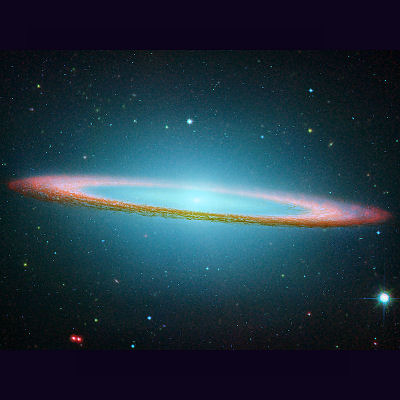 This floating ring is the size of a galaxy. In fact, it is part of the photogenic Sombrero Galaxy, one of the largest galaxies in the nearby Virgo Cluster of Galaxies. The dark band of dust that obscures the mid-section of the Sombrero Galaxy in optical light actually glows brightly in infrared light. The above image shows the infrared glow, recently recorded by the orbiting Spitzer Space Telescope, superposed in false-color on an existing image taken by NASA's Hubble Space Telescope in optical light. The Sombrero Galaxy, also known as M104, spans about 50,000 light years across and lies 28 million light years away. M104 can be seen with a small telescope in the direction of the constellation Virgo. — Editors of the Astronomy Picture of the Day website describing
This floating ring is the size of a galaxy. In fact, it is part of the photogenic Sombrero Galaxy, one of the largest galaxies in the nearby Virgo Cluster of Galaxies. The dark band of dust that obscures the mid-section of the Sombrero Galaxy in optical light actually glows brightly in infrared light. The above image shows the infrared glow, recently recorded by the orbiting Spitzer Space Telescope, superposed in false-color on an existing image taken by NASA's Hubble Space Telescope in optical light. The Sombrero Galaxy, also known as M104, spans about 50,000 light years across and lies 28 million light years away. M104 can be seen with a small telescope in the direction of the constellation Virgo. — Editors of the Astronomy Picture of the Day website describing 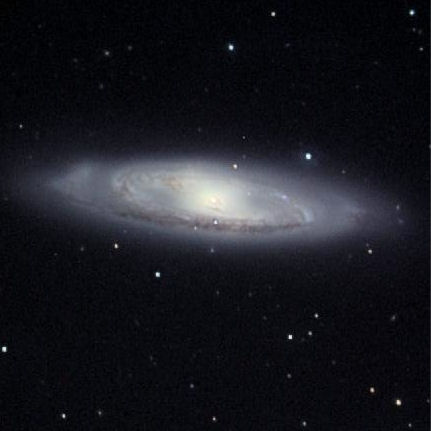 Our next galaxy is from the Sa group and is the well known spiral M65 in the constellation Leo, also known as NGC 3623 and shown at left. At a distance of about 35 million light-years, this galaxy is typical of the class, having a structure of very tightly wound spiral arms and a large central nuclei. The image was obtained during a session of the
Our next galaxy is from the Sa group and is the well known spiral M65 in the constellation Leo, also known as NGC 3623 and shown at left. At a distance of about 35 million light-years, this galaxy is typical of the class, having a structure of very tightly wound spiral arms and a large central nuclei. The image was obtained during a session of the 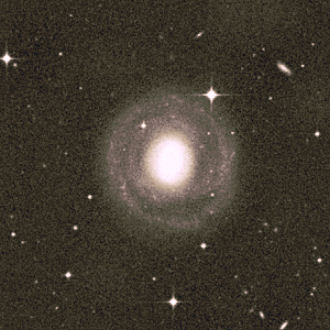
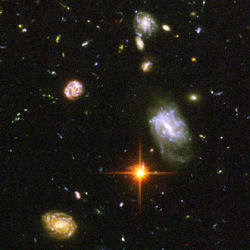 Shown at left is the face-on image of galaxy NGC 1302, another example of the Sa class that is located in Fornax, the Furnace. This image was obtained from the
Shown at left is the face-on image of galaxy NGC 1302, another example of the Sa class that is located in Fornax, the Furnace. This image was obtained from the 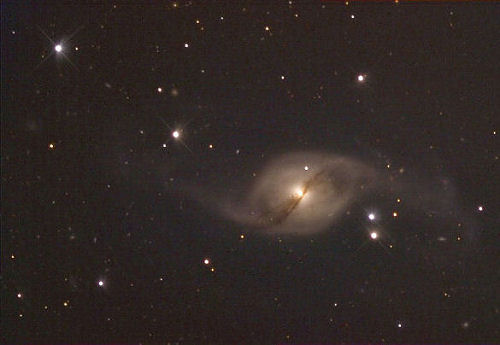
 At left is a close-up of NGC 3718 showing the twisting structure of the of dust and gas as it crosses the central disk of the galaxy. It is from an optical image taken in the V band and reduced by
At left is a close-up of NGC 3718 showing the twisting structure of the of dust and gas as it crosses the central disk of the galaxy. It is from an optical image taken in the V band and reduced by  At right is NGC 4064, a Sb/Sba peculiar galaxy on the outskirts of the Virgo Cluster that was a target of a 2004-05 survey, along with NGC 4424, on the combined process and actions of ram pressure stripping and gravitational interactions using the galaxy's current morphology and chemical composition. fn1 The survey noted that this combination of effects would transform the morphology of these galaxies and summarized the eventual evolutionary developement of both NGC 4064 and 4424 towards an S0 type galaxy (
At right is NGC 4064, a Sb/Sba peculiar galaxy on the outskirts of the Virgo Cluster that was a target of a 2004-05 survey, along with NGC 4424, on the combined process and actions of ram pressure stripping and gravitational interactions using the galaxy's current morphology and chemical composition. fn1 The survey noted that this combination of effects would transform the morphology of these galaxies and summarized the eventual evolutionary developement of both NGC 4064 and 4424 towards an S0 type galaxy (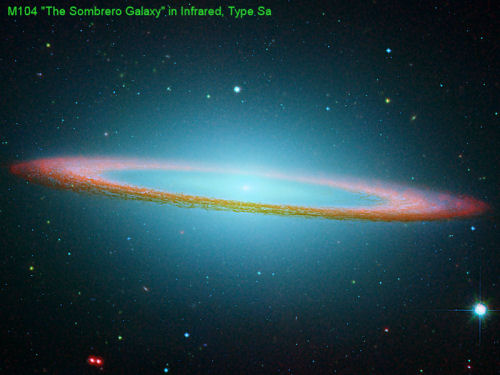 With just a 6 degree tilt south of its equatorial plane (
With just a 6 degree tilt south of its equatorial plane (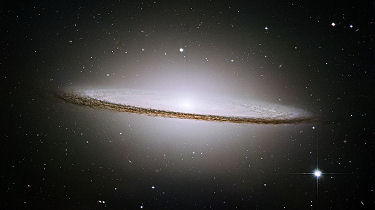
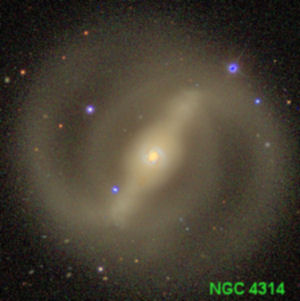 Our representative galaxy for the SBa class goes to the most distinguished NGC 4314 in the constellation Coma Berenices or Berenice's Hair, a constellation based on a story about the real life Egyptian Queen
Our representative galaxy for the SBa class goes to the most distinguished NGC 4314 in the constellation Coma Berenices or Berenice's Hair, a constellation based on a story about the real life Egyptian Queen 